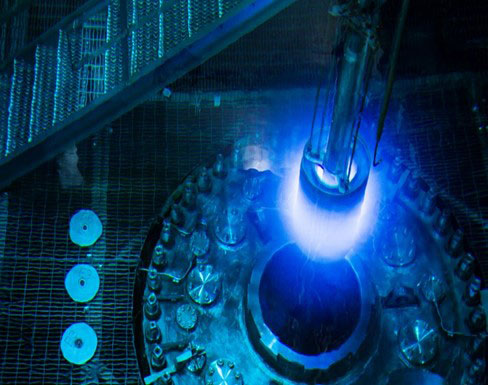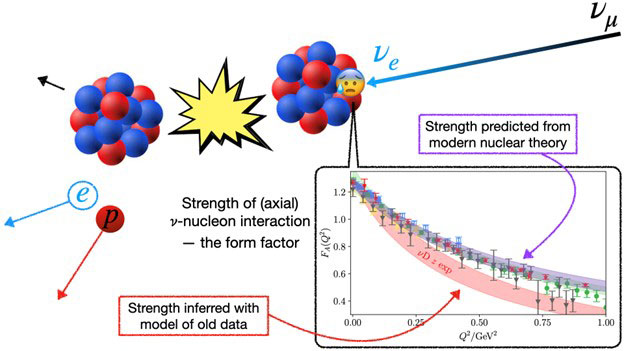Experiments
Intensity Frontier researchers investigate some of the rarest processes in nature, including unusual interactions of fundamental particles and subtle effects that require large data sets to observe and measure.
The Office of High Energy Physics supports the following experiments and facilities at the intensity frontier:

at the High Energy Accelerator Research Organization (KEK), Japan
Belle II aims to precisely measure physical properties of quarks and leptons, search for the source of matter-antimatter asymmetry in the universe today, and discover new states of matter. The Belle II detector measures matter containing bottom quarks produced by electron-positron collisions from the SuperKEKB accelerator.

at the Beijing Electron Positron Collider, China
The Beijing Electron Spectrometer experiment aims to search for the source of matter-antimatter asymmetry in the universe and discover new states of matter. BES III advances this science through precision measurements of matter containing charm quarks, produced by electron-positron collisions.

at Daya Bay, China
The Daya Bay Neutrino Experiment uses the flux of anti-neutrinos produced by the Daya Bay Nuclear Power Plant and the Ling Ao Nuclear Power Plant reactors to accurately measure the parameters of neutrino oscillations and search for signs of new physics.

at the Waste Isolation Pilot Plant, New Mexico
The Enriched Xenon Observatory aims to determine the nature of neutrinos and their antiparticles by using a sensitive underground detector to search for neutrinoless double beta decay.

at Thomas Jefferson National Accelerator Facility, Virginia
The Heavy Photon Search hunts for heavy photons, also called dark photons, which may be mediators of a force through which dark matter interacts. HPS looks for electrons and positrons that may have come from dark photons produced by the Continuous Electron Beam Accelerator Facility (CEBAF).

at the Japan Proton Accelerator Research Complex, Japan
The KOTO experiment is to searches for new physics that would explain the matter-antimatter asymmetry in the universe today. KOTO aims to measure the rate of a particle interaction that is predicted to be very rare by the Standard Model, but could be greatly enhanced by new physics.

at Fermi National Accelerator Laboratory and the Sanford Underground Research Facility, South Dakota
The international Deep Underground Neutrino Experiment will enable a world-leading program that advances the science of neutrino oscillations, matter-antimatter asymmetry, supernova neutrinos, and proton decay. DUNE will be served by the Long-Baseline Neutrino Facility, which will send the most powerful neutrino beam in the world 800 miles through the earth, from Batavia, IL to the Lead, SD. As the first U.S.-hosted megascience facility, LBNF will engage the worldwide scientific community as it enables a global program of discovery in particle physics.

at Fermi National Accelerator Laboratory
MicroBooNE is a short-baseline neutrino experiment that uses Booster Neutrino Beam in an effort to conclusively address neutrino physics beyond the Standard Model, while making important measurements of the rate of neutrino interactions with argon. MicroBooNE is the first large neutrino detector built in the U.S. to use a Liquid Argon Time Projection Chamber, the technology of choice for the eventual international Deep Underground Neutrino Experiment.

at Fermi National Accelerator Laboratory
MINERvA will perform precise measurements of low energy neutrino interactions with a variety of materials using the Neutrinos at the Main Injector (NuMI) beam. MINERvA will advance the understanding of neutrinos-nuclei interactions while providing important information for the future neutrino science program.

at Fermi National Accelerator Laboratory and Soudan Underground Laboratory, Minnesota
The MINOS+ Experiment is a long-baseline neutrino experiment designed measure key parameters of neutrino oscillation. MINOS+ uses two detectors, a near detector located at the source of the intense Neutrinos at the Main Injector (NuMI) beam at Fermi National Accelerator Laboratory in Illinois and a far detector, 450 miles away, at the Soudan Underground Laboratory at the Soudan Underground Mine State Park in Minnesota.

at Fermi National Accelerator Laboratory
The Mu2e experiment will search for the direct conversion of a muon to an electron, an extremely rare process in the Standard Model that would be greatly enhanced by new physics. Mu2e is designed to have 10,000 times greater sensitivity to this process than that of previous experiments.

at Fermi National Accelerator Laboratory
The Muon g-2 experiment will perform a precise measurement of the magnetic moment of the muon. Measuring g-2 with high precision allows physicists to discover whether the experiment agrees with theory or gives definitive evidence of new physics.

at Fermi National Accelerator Laboratory and Ash River, Minnesota
NOvA will measure the parameters of neutrino oscillations in order to gain a better understanding of the nature of neutrinos and perhaps determine the ordering of neutrino masses. The NOvA experiment collects data from the world’s most powerful neutrino beam, the Neutrinos at the Main Injector (NuMI) beam at Fermi National Accelerator Laboratory, using the world’s longest neutrino baseline, 500 miles, from Batavia, IL to Ash River, MN.

at Fermi National Accelerator Laboratory
The Short Baseline Neutrino Program at Fermilab, which will add SBND and ICARUS to the Booster Neutrino Beam, aims to conclusively address experimental hints of physics beyond the three-neutrino model by making precise neutrino oscillation measurements. These detectors will also further physicists’ understanding of liquid argon technology for use in the international Deep Underground Neutrino Experiment at the Long Baseline Neutrino Facility.

at Mount Kamioka, Japan
Super-Kamiokande aims to reveal key neutrino properties through observations of solar neutrinos, atmospheric neutrinos and man-made neutrinos. Located 3,300 feet underground, Super-K uses 50,000 tons of pure water surrounded by over 11,000 photo-detectors to observe the cone of light formed when a neutrino interaction occurs.

at the Japan Proton Accelerator Research Complex and Mount Kamioka, Japan
Tokai to Kamioka investigates how neutrinos change from one flavor to another as they travel. An intense beam of muon-type neutrinos is generated at the J-PARC nuclear physics site on the East coast of Japan and directed 180 miles across the country to the Super-K water-based neutrino detector in the mountains of western Japan.



















